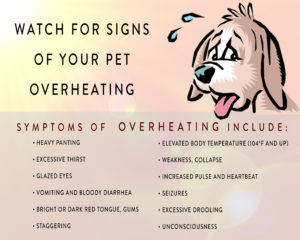
Summer safety tips
Orchard House Veterinary Centres Summer Safety Tips!
- Plan your walk
Plan the route of your walk to include plenty of shade and remember to take plenty of water on your journey. Walk your dog in the early morning or late in the evening when temperatures are cooler so they will be at reduced risk of heatstroke and try stay in the shade as much as possible. Be particularly careful if your dog is unfit, obese or suffers from breathing difficulties. - How hot is the ground?
Tarmac can get very hot in the sun, check it with your hand before letting your dog walk on it so they do not burn their paws. Place your hand on the ground for seven seconds, if it is too hot for your hand, it is too hot for your dog! Either walk your dog later or stick to sheltered grassy areas. - Provide shade and water
Make sure your dog has access to plenty of water and shade, this is so important and will make them feel much more comfortable. - Don’t let them get burnt
It is a common misconception that dogs cannot get sunburnt, they can, and they do! Use pet-safe sun cream on exposed parts of their skin such as the tips of their ears and nose and avoid direct sunlight where you can – ask your vet for further advice if needed.

What to do if your dog overheats
If your dog is too hot and unable to reduce their body temperature by panting, they could develop heatstroke which can be fatal. Dogs with certain diseases or on some types of medication are also more prone to heatstroke. If you have any concerns about the heat and the medication your pet takes, please contact us!
Some dogs are more prone to heatstroke than others, such as very old or young dogs, those with thick heavy coats or those with short, flat faces (such as Pugs and Boxers). Where possible, avoid overheating, even in the shade!
What are the symptoms of heatstroke in dogs?
- Panting heavily
- Appears lethargic, drowsy or uncoordinated
- Drooling excessively
- Vomiting
- Collapsing
If your dog is showing any of the signs, please contact your vet immediately.
Dogs die in hot cars
Think twice about any car trips with your dog – avoid congested roads or busy times of day when they could overheat in the car if you are caught up in traffic. If driving with your dog plan your journey considering cooler times of the day and places to take breaks.
In just 20 minutes, a dog could die in a hot car. Winding a window down is not enough to help your dog – never leave you dog in a warm car. If you see a dog in distress in a hot car, call 999 immediately.
Emergency first aid for dogs with heatstroke
For the best chance of survival, dogs suffering from heatstroke urgently need to have their body temperature lowered, but this needs to be done gradually or they can go into shock. If your dog has collapsed, call your vet immediately as they may advise attending as a matter of emergency rather than starting treatment yourself.
What can you do to help if you suspect your dog may be overheating?
- Move the dog to a shaded and cool area.
- Immediately start pouring small amounts of room temperature (not cold) water onto the dog’s body (cold water may cause shock). If possible, you can also use wet towels or place the dog in the breeze of a fan. If using wet towels, be sure to re-apply water regularly and not to keep the dog constantly covered – sometimes this can heat them up instead of cooling them down.
- Allow the dog to drink small amounts of room temperature water.
- Continue to pour small amounts of room temperature water onto the dog until their breathing starts to settle but not so much that they start to shiver.
- Once the dog is starting to get cooler and their breathing is settling down, call your veterinary surgery so they can be checked over.

